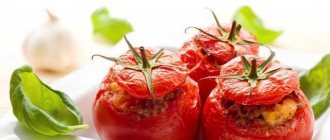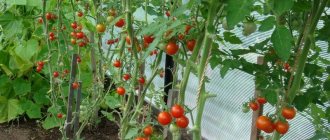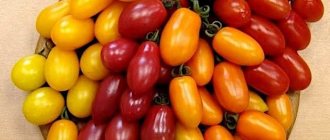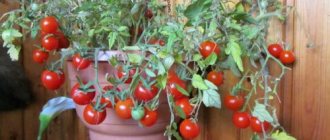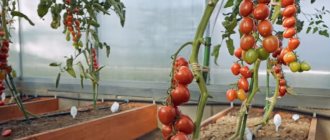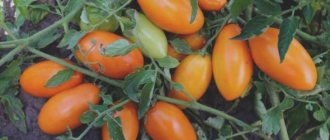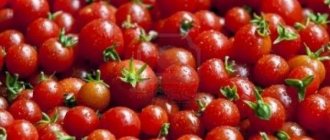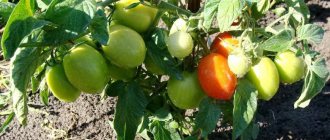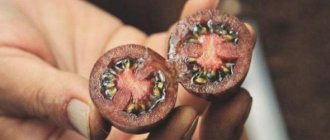The Madeira F1 tomato produces bright, neat cherry tomatoes that housewives like for their excellent taste, the possibility of canning, pickling, and wide use in summer cooking.
| Height | Landing location | Ripening time | Fruit color | Fruit size | Origin | Fruit shape |
| Tall | Greenhouse, Open ground | Early ripening | Reds | Small | Hybrid | Round |
Tomato Madeira - description and characteristics of the variety
Main features of the hybrid
Madeira F1 is an early-ripening hybrid belonging to the family of cherry varieties. The fruits ripen 3 months after emergence.
General description of the variety:
- On average, the rise of bushes of this variety is from one and a half to two meters. The trunk of the plant is very dense and durable, thanks to which even a wolf could break it off.
- The leaves are medium in size, their number on the plant is moderate.
- About 12-15 ovaries are formed in each raceme; the inflorescences are simple.
- The Madeira variety is characterized by high yield. From 1 square meter you can collect 5-7 kg of fruit.
- The advantage of this hybrid is that it is resistant to many diseases characteristic of tomatoes.
Pomona gifts have the following characteristics:
- They are perfectly round in shape.
- Their price is small, on average it is about 21-25 g.
- The skin is very thin and smooth.
- One can also say that it is an advantage that the fruits fall off the bush when ripe and do not crack.
- Ripe fruits have a bright garnet hue.
- Inside they are divided into 2 segments.
- The tomato pulp is dense and very juicy.
Tomatoes can be stored for quite a long time and can withstand transportation well over long distances, without losing their marketability. This makes the variety quite popular for growing for sale.
This hybrid variety is universal and can be grown for use for various purposes. Madeira buttocks can be planted both in regular greenhouses and in temporary shelters under film. Summer residents harvest a good harvest even in an open area. Wonderfully suitable even for growing on a windowsill in a city apartment.
Unless you live in the southern region, Madeira can be planted without growing seedlings. You need to wait for the soil to warm up to a temperature of about 17 degrees.
Recommendations for cultivation
- To grow seedlings, sowing must be done on March 10-15. Seeds are planted to a depth of 1 cm. It is not recommended to deepen them deeper than that.
- After sowing, you need to moisten the quicksand, cover it with transparent plastic film, and then put it in a warm place.
- After 2 leaves are formed on the plant, they are picked, planted exactly in separate small containers. At this time, you need to carry out the first feeding.
- 2 months after sowing, seedlings are planted in the ground. But at the same time you need to make sure that it will not be affected by night frosts. If you plan to plant seedlings in greenhouses, then this can be done within 1 month after sowing.
- To obtain high grain yield, it is necessary not only to grow high-quality seedlings, but also to prepare the soil in advance. Plants of this variety will grow well in any soil, but loamy and sandy soils are more suitable for it. If you doubt the quality of the soil, be sure to enrich it with fertilizers before planting seedlings. Compost, kelp, and egg shells are suitable. Feeding in the form of bird droppings or rotted cow manure diluted with water will also be very useful.
- It is recommended to plant exactly according to the 60x70 cm pattern. But when grown in a greenhouse, it is possible to plant even more densely.
- During the growth process, plants must be shaped, leaving 1-2 stems. Except that they require a garter.
- Next, the tomatoes are cared for in the usual way. They need to be regularly provided with moisture, weeds removed, hilling and fertilizing. The buttocks of this variety respond well to the application of mineral mixtures and organic fertilizers.
These small fruits will become a real decoration for your garden. They have a pleasant dessert flavor and will be a wonderful addition to many dishes.
Features of the variety
Madeira F1 is an early ripening hybrid of cherry tomatoes. The plant is a carpal plant of indeterminate type. The first harvest can be harvested within 85–90 days after germination.
Description of the variety:
- height of bushes from 1.5 to 2 m;
- the stem is dense and strong, has no tendency to break off;
- medium-leaved plant, medium-sized leaves;
- inflorescences are simple, each raceme contains from 12 to 15 ovaries;
- the yield is high - from 4.5 to 7 kg per 1 sq. m;
- The hybrid is highly resistant to many tomato diseases.
Fruit characteristics:
- the shape of the fruit is perfectly round;
- weight of tomatoes 20–25 grams;
- the skin is thin and smooth;
- tomatoes are not prone to cracking and falling;
- the color of ripe fruits is bright red;
- inside the tomato is divided into two segments;
- the pulp is dense and juicy;
- tomatoes last a long time and tolerate transportation well without losing their presentation.
This is interesting: How to feed a pear in the fall for a good harvest
The hybrid variety Madeira is suitable for universal use.
Tomato F1 Madeira Blog: Cottage and garden
F1 Madeira is an indeterminate high-yielding hybrid of the first generation (F1) for open ground and film greenhouses, tunnels. Early ripening. The period from germination to the beginning of fruiting is 85-90 days. The fruits are round, smooth, dense, red, weighing 20-25 g. Taste - . , “excellent taste - delicious cherry tomatoes.” Universal use. Disease resistance - “resistant to cracking and shedding, TMV, Fusarium wilt, cladosporiosis, Alternaria.” Feature: Fruits are collected in 13-15 pieces in an ideally shaped brush, excellent transportability. (- description from the back of the bag of seeds + my comments).
Recommended conditions: for cultivation in open ground, film greenhouses.
Sowing for seedlings: mid-March. Seed placement depth: 1 cm. Picking: in the phase of the first true leaf. Planting seedlings in open ground - at the age of 30 - 35 days. Planting pattern - 70 by 60 cm.
Fruiting: starting in mid-July.
The key to choosing this tomato hybrid was its early ripeness, as well as its declared “delicacy taste”, as an alternative to the well-proven Thumbelina tomato.
About F1 Madeira tomato hybrids from the blog:
March 10, 2021. Last summer, to put it mildly, turned out to be more favorable for mushrooms than for tomatoes. Although we managed to harvest a normal tomato harvest, some questions arose regarding the planted varieties. The discovery of the “a la cherry” tomato variety Thumbelina, which pleased me a year earlier, was a little puzzling this year - the tomatoes were almost 2 inches long, and only began to turn red in the second half of August. Therefore, this year I selected a hybrid for comparison, also “a la cherry” - F1 Madeira. According to the seed manufacturer, these are very early and “delicious cherry tomatoes on huge red clusters.”
March 12, 2021. In the morning, the seeds were soaked, and in the evening, tomatoes were sown for seedlings for the greenhouse and open ground (F1 Madeira, Thumbelina): tomatoes of the Pertsevidny and Thumbelina varieties were sown; and hybrids F1 Pride, F1 Madeira. We have not used growth stimulants during soaking for several years now - they do not affect germination, and the appearance of the first shoots one day earlier is not significant. All crops were carried out with precise depth.
Comments are published on the forum online and on this page after approval by the moderator.
What is an F1 hybrid? In our case, this is the result of crossing two tomato varieties, the first generation, i.e. Simply put, seeds obtained as a result of pollination of flowers of one tomato variety with pollen from another variety.
Why are F1 hybrids so common? The designation F1 stands for very simply: the offspring of the first generation. This designation has been preserved since the time of Mendel (the discoverer of the laws of genetics), he then introduced it as an abbreviation for the Latin Filiale 1, and for us it will be mnemonically easier to use the word “Formation 1”. But the main point is not in the designation, but in the fact that it is the first hybrid generation that has two remarkable properties: - the first property, according to the law of uniformity of hybrids of the first generation, is that the similarity of all these plants to each other is higher than that of plants of a well-established varieties; - the second property is that first-generation hybrids have increased vitality, they are larger than their parents and grow faster than them, and most importantly, they are more resistant to diseases - this phenomenon is called “heterosis” in genetics.
So, do not try to save the seeds of the hybrids you like; the F2 hybrid generation grown from these seeds will not have either the first or second properties. The only thing you may be able to get from them is to find out which varieties were the parents of the F1 generation hybrids.
Tomatoes are very popular vegetables grown in various climate zones. Every gardener tries to find a variety that will require fewer resources and produce more healthy products with excellent taste. In this article we will talk about the Madeira tomato, discuss its characteristics and description. We will also consider the strengths and weaknesses of this variety.
Advantages and disadvantages of the variety
Based on the given characteristics and descriptions of the Madeira tomato variety, we can highlight its advantages and disadvantages.
- Excellent taste;
- The harvest can be harvested as early as mid or late July;
- The hybrid has great resistance against the most common diseases;
- Easy to transport;
- The plant can be grown both in a greenhouse and in open soil;
- High growth allows you to save more space;
- The small size of the fruit is ideal for canning.
- The plant needs a garter and additional support;
- The variety requires fertile soil with excellent drainage properties;
- Cold climate zones are not suitable for growing this variety;
- When growing in a greenhouse, considerable costs are required;
- The variety needs to allocate an area with good lighting.
Having examined the Madeira variety, we can say with confidence that not every variety can boast of identical fruits and excellent commercial qualities.
Important to remember! To get a good harvest, the plant needs to create favorable conditions for growth, and then it will be able to please with a truly rich and tasty harvest.
Description and characteristics of the variety
In terms of ripening time, the tomato belongs to the mid-season range. The first harvests are harvested 111-115 days after germination. The variety is cultivated universally - in open and closed areas.
The tomato has the following characteristics of the bushes:
- determinant growth;
- thickened, strong stems;
- average height 60-75 cm;
- inflorescences intermediate;
- 1 brush after 8-9 leaves;
- all subsequent clusters after 1-2 leaves.
Tomatoes are well preserved and transported without loss of marketability and beautiful appearance. Can be used universally – for fresh dishes and preparations.
Fruit characteristics:
- average weight 80-100 g;
- the flesh is dense, fleshy;
- slightly flattened shape;
- there is light ribbing;
- 6 seed chambers, few seeds;
- the skin is strong, not cracking;
- the coloring is bright;
- the taste is pleasant, sweetish.
Smooth tomatoes are well suited for canning due to their small size and canning properties. They produce aromatic juices and thick, flavorful sauces.
Origin of the variety
The raspberry egg capsule represents the result of agricultural breeding activities. The variety is included in the list of the State Register of Russia.
Which regions are best to grow in?
The tomato is well adapted to various conditions and is cultivated in protected and open ground. Farmers advise planting the variety:
- in the temperate zone, the Central region for temporary shelters;
- in the south (Crimea, Astrakhan) to open-air beds;
- in the northern regions in greenhouse structures.
Description of the variety
Fruit characteristics
- The fruits of the Madeira f1 tomato have a perfectly smooth and rounded shape;
- Light weight of tomatoes – 20-25 grams;
- Up to 16 fruits can form on one brush;
- The tomato has a bright red rich color;
- The pulp of the fruit is juicy and dense;
- Cherry tomatoes have a high yield - on average, up to 6-8 kg can be harvested from 1 m2;
- Harvesting usually takes place from mid-July;
- The variety is perfect for both canning and making salads and tomato juice, as well as for fresh consumption;
- Tomatoes do not have a tendency to crack and fall;
- The variety is well stored and tolerates transportation. It should be stored in a cool, semi-shady place. Shelf life – from 2 to 3.5 weeks;
Disease resistance
A characteristic feature of Madeira tomatoes is their high resistance to diseases such as: TMV, Alternaria blight, Verticillium blight, Cladosporiosis, Fusarium wilt.
But, despite such high resistance, the plant must be periodically treated against various pests and fungi.
Description of the Madeira tomato and recommendations for planting seedlings
Many gardeners take great pleasure in growing cherry tomatoes on their plots. The Madeira tomato also belongs to this species. It has a number of advantages that make it so popular among vegetable growers.
A high-yielding and unpretentious plant is capable of giving its owner about 10 kg of fruit per 1 m² in one season. The taste of small tomatoes is excellent. The fruits have sugary and at the same time acidified pulp, which combines spicy and fruity notes.
general description
Madeira tomatoes can be used universally. They are ideal for making salads; you can use them to create a paste and juice, preserve them whole or add them to lecho. Fragrant cherry tomatoes are suitable for preparing spices. Due to the large amount of dry matter they contain, they can be dried.
Before you start growing this variety of nightshade, you should familiarize yourself with all the requirements and features of the process of growing and caring for the plant.
The variety Madeira F1 belongs to the indeterminate species. An adult bush grows no more than 1.5 m in height. It has a neat appearance. The foliage on the plant is sparsely located, has a dark green color, and is slightly elongated in shape.
Tomatoes can be grown both in open ground and in greenhouse conditions. Small Madeira bushes do well at home, so gardeners successfully grow cherry tomatoes on their balconies.
The bush has a strong stem and dense powerful shoots. It is still worth putting a support for further garter, although many gardeners do without it.
It is resistant to cladosporiosis, TMV, fusarium wilt, and tobacco mosaic virus. But the plant must be treated periodically against pests and fungus.
Description of fruits:
- The fruits of the Madeira variety are small, each weighing on average about 20 g.
- There are from 13 to 16 tomatoes on one brush.
- Tomatoes are red.
- Their peel is smooth and shiny, quite dense. Thanks to it, the fruits tolerate heat and long-term transportation well.
- The productivity of cherry tomatoes is high.
- You can store picked tomatoes for a long time - about 3-4 weeks.
- Harvesting takes place from mid-July.
Madeira cherry tomatoes have excellent taste and are suitable for universal use.
Growing seedlings
When purchasing seeds of the F1 Madeira variety, you need to study the description and recommendations that are on the back of the package. As a rule, the manufacturer indicates the optimal time for sowing and planting seedlings in open ground.
Seeds are sown for seedlings in mid-March. For this purpose, use a special container or box. You should prepare the soil yourself. To do this you will need one part of the earth and the same amount of peat and sand. All components are mixed and slightly moistened.
Seeds can be soaked in a manganese solution before sowing. This will increase the plant's resistance to many pests. Vegetable growers soak seeds in a solution with a growth stimulator. It is believed that this drug allows you to grow stronger and stronger seedlings. After soaking, the seeds must be dried in sunlight.
The seeds are deepened into the soil by 1 cm, no more. After planting, the seedlings are covered with film and placed in a warm and well-lit place. Every day, the box with planting material must be opened to ventilate the soil, which will avoid stagnation of moisture.
As soon as the first strong leaves appear on the young shoots, you can transplant them into peat pots or other small containers. Picking into peat containers allows you to further simplify the process of planting plants in open ground. The seedlings can be deepened into the soil along with the pot.
Planting seedlings
Seedlings can be planted only if the weather outside is good and the ground has warmed up well enough. Planting material of the F1 Madeira variety is planted in a permanent place after 30-35 days. The first half of May is ideal for this. The second half of June is the deadline for planting.
Before planting, the beds need to be dug up well and humus added to the soil. The seeds are planted according to the scheme, the distance between the bushes should be 70 cm, and between the rows - 60 cm.
Further care consists of regular watering, fluffing up the soil and weeding the beds. The F1 Madeira variety also requires periodic feeding with mineral fertilizers.
Planting seedlings
Seedlings can be planted only if the weather outside is good and the ground has warmed up well enough. Planting material of the F1 Madeira variety is planted in a permanent place after 30-35 days. The first half of May is ideal for this. The second half of June is the deadline for planting.
Before planting, the beds need to be dug up well and humus added to the soil. The seeds are planted according to the scheme, the distance between the bushes should be 70 cm, and between the rows - 60 cm.
Further care consists of regular watering, fluffing up the soil and weeding the beds. The F1 Madeira variety also requires periodic feeding with mineral fertilizers.
Read also: What to look for when choosing a watermelon
Growing and care
The Madeira F1 tomato is intended for growing in greenhouses, temporary tunnel-type film shelters and open ground, as well as in urban environments: on balconies and window sills. In the southern regions of the country, planting without seedlings is possible when the ground warms up to +16–18 degrees. Agricultural technology:
- Seeds are sown for seedlings in mid-March. It should be sown to a depth not exceeding 1 cm. After sowing, the soil should be moistened, covered with film and placed in a warm place.
- When the first pair of true leaves is formed, the sprouts are planted in separate containers. And they carry out the first feeding.
- At the age of 55–60 days, the seedlings are ready for planting in open ground, provided that the threat of night frosts has passed. You can start planting in greenhouses at the age of 30–35 days.
- Pre-prepared soil will guarantee a good harvest. The Madeira tomato variety takes root on any type of soil, but develops and bears fruit more successfully on sandy and loamy soils. If the quality of the substrate is lower, it is worth adding fertilizers before planting. To do this, you can use compost, wood ash, eggshells, poultry droppings or diluted rotted manure.
- The recommended planting pattern is 70x60 cm; denser planting is possible in greenhouses.
- As the bushes grow, they require formation into one or two stems and tying to a support.
- In the future, caring for tomatoes does not differ from standard growing methods: they also require regular watering, weeding, hilling and fertilizing. The Madeira tomato responds well to fertilizing with organic and mineral mixtures.
Baby tomatoes of the Madeira variety will decorate any garden and will delight you with the pleasant dessert taste of the fruit.
Galina Danilova, Kazan:
“Last season I planted the Madeira variety. I liked them both fresh and marinated. Neat and beautiful tomatoes, easy to eat.”
Yulia Drozdova, Cherepovets:
“I’m planting Madeira for the second year in a row. The tomatoes sprout quickly and bear fruit superbly, so be sure to pick them in time. The skin is thin, delicate, but does not burst in the sun.”
Lyubov Nikulina, Moscow:
“I really like cherry tomatoes. I planted Madeira for the first time last year as an experiment. The result exceeded all my expectations. The tomatoes are small, even, beautiful and very tasty.”
Growing tomatoes
The Madeira tomato is intended for planting both in greenhouses and in open ground; the variety can also be grown on balconies and window sills. In the southern regions, the plant can be planted using the seedless method. It is important that the soil warms up well and has a temperature of +16-18 degrees.
Sowing in warm soil
The first sowing of seeds is carried out in the second half of March. Before planting, they should be soaked in a manganese solution. This will increase resistance to many diseases and pests.
Experienced vegetable growers also recommend keeping seeds in a special solution that stimulates growth. Thanks to this drug, the seedlings grow stronger and stronger. After soaking, the seeds must be dried in sunlight.
Next, plant the seeds in shallow containers. Good soil can be purchased at specialty stores. After the soil is filled, it should be slightly moistened and then the seeds should begin to be planted. They are sown to a depth of 1 cm. The distance between the seeds should be 2-3 cm. After sowing, the container with the seedlings is covered with film and placed in a warm place. Air humidity should not exceed 60%, otherwise there is a high probability of the bushes being damaged by fungal diseases. Flower stalks will fall off, and pollination will greatly deteriorate.
Read also: Proper planting and characteristics of Rapunzel tomatoes
As soon as 2-3 full-fledged leaves are formed, the sprouts dive into separate containers. Peat pots filled with substrate are ideal for this. They allow you to easily transfer seedlings without damaging their root system.
When the seedlings reach the age of 50-60 days, they can be planted in open ground. But it is important that the threat of night frosts passes.
Seedlings can be planted in greenhouses after 30-35 days.
Important! Pre-prepared soil will guarantee a good harvest. Madera tomatoes easily take root in any type of soil. However, sandy and loamy soils are much better suited for tomatoes. On them it develops faster and bears more fruit.
The standard parameters for planting are 70x60 cm; in greenhouses, denser planting is possible.
Rules for caring for tomatoes
- Since the variety is an indeterminate species, its stems stretch upward and tend to bend and break, so the plant must be tied to a support;
- The plant needs pinching. The leaves located at the bottom of the first cluster with fruits must be removed. This process should be performed in the morning;
- In order for the variety to produce a good harvest, it must be promptly fed with mineral fertilizers that contain organic elements;
- As for watering, watering every 3-5 days will be sufficient for the plant. Up to 5 liters of water are required per 1 m2.
Features of cultivation
The Madeira tomato, according to the description, is a cherry tomato - accordingly, it is grown using a similar technology.
Since our hybrid can be cultivated in open ground, we will consider several cultivation options.
If you are familiar with large-fruited tomatoes and have planted them in open ground, then there will be no problems with cherry tomatoes, since they are grown in much the same way.
Tomatoes need feeding during the growing process. Egg shells, nettle fertilizer, ash, chicken droppings, and mullein solution are suitable for this. You can also use superphosphate, potassium sulfate and nitrophoska.
Let's start with the soil. To get a good harvest, the site should be dominated by sandy or loamy soil, rich in humus and minerals. In this case, the substrate must have good drainage properties so that moisture does not remain in it. If you have “bad” soils on your site, you will need to add humus/compost, mineral water, or purchase ready-made soil.
It is worth understanding that if you save on the substrate, then the amount of production will be corresponding, so weigh your income and expenses and find the best option.
Regarding the climate. If you live in the south, and in April the daytime temperature is between 16-20°C, the seeds can be sown directly into the ground. If the weather is not stable, it is better to use the seedling method. You can sow seeds in the ground or in boxes for seedlings using one system.
We make beards up to 0.5 cm deep in the soil, lay out the seeds in a row and sprinkle with soil.
It is important that the seeds are not deeply “hidden” in the ground, otherwise they will not have enough strength to sprout
After planting all the seeds, you need to moisten the soil. If they were planted in boxes, we move them to the south side, where the air temperature will be between 25-28°C.
Important! Daylight hours should be at least 10 hours. The first shoots will appear in a week and a half
This is when you need to reduce the temperature to 20˚C if you are using the seedling method. We check the substrate daily for moisture and do not allow it to dry out or become waterlogged.
The first shoots will appear in a week and a half. This is when you need to reduce the temperature to 20˚C if you are using the seedling method. We check the substrate daily for moisture and do not allow it to dry out or become waterlogged.
Seedlings need to be planted in separate cups in the phase of 3 true leaves. We do everything carefully so as not to damage the roots. When replanting, we slightly deepen the stem to get additional roots. When caring for seedlings in open ground, you can lightly hill up the rows to get a similar effect.
Seedlings should be planted when the temperature at night does not drop below 10°C, but it is worth remembering that the deadline for planting is the second ten days of June, so if you do not have time to “relocate” your tomatoes, they will have to be grown indoors.
It is necessary to plant according to a certain pattern in order to make maximum use of the area and not thicken the plantings. The distance between adjacent plants in a row is 0.7 m, between rows - 0.6 m.
Important! When the bush is 30 cm high, it needs to be tied to a support. As for growing in a greenhouse, only the planting time and scheme change
Bushes can be planted closer to each other
As for growing in a greenhouse, only the planting time and scheme change. Bushes can be planted closer to each other.
It is also worth remembering that if the greenhouse is not heated, sowing seeds is extremely undesirable. Only seedlings that have undergone minimal hardening can be transferred to a “cold” greenhouse.
Description of the variety
Here we have a typical representative of cherry tomatoes, which can be grown both in a greenhouse and in various tunnels or in open ground.
The indeterminate plant has slightly spreading shoots and can grow up to 1.5-2 m in height . The leaf blades are dark green and medium in size. The stem and shoots are quite dense, resistant to gusts of wind and cracking.
Small red tomatoes with smooth skin. The number of nests is 2. Up to 16 fruits are formed on one hand , with an average weight of 20 g.
The products have excellent taste and are well transported, which allows them to be used both fresh and for juice production, canning or preparing various dishes. It is worth noting that up to 7 kg of fruit can be collected from one square meter, but this is only if you followed the standard planting pattern when picking.
A positive quality is that these tomatoes do not crack in the heat and do not fall off after ripening.
Video
We offer you to watch a video on the topic of the article:
About the author:
Found a mistake? Select the text with the mouse and click:
Ctrl + Enter
Do you know that:
Compost is rotted organic remains of various origins. How to do it? They put everything in a heap, hole or large box: kitchen scraps, tops of garden crops, weeds cut before flowering, thin twigs. All this is layered with phosphate rock, sometimes straw, earth or peat. (Some summer residents add special composting accelerators.) Cover with film. During the process of overheating, the pile is periodically turned or pierced to bring in fresh air. Typically, compost “ripens” for 2 years, but with modern additives it can be ready in one summer season.
Agricultural technology for growing a hybrid
Like other varieties and hybrids of tomatoes, Matias is grown in seedlings. To get an early harvest, seeds are planted for seedlings in mid or early March (depending on the weather conditions of the region). After planting in fertile, loose soil, containers with seedlings are covered with film until the seeds germinate. As soon as the seeds hatch, the film is removed and the plants continue to be grown in an open, warm and sunny place, maintaining the room temperature at 24–26 degrees.
After the leaves appear, the seedlings are planted in separate containers and grown until the onset of warm weather conditions outside. Plants are transplanted into the greenhouse in May-June; this also depends on the temperature in the room. The optimal values are 22–25 degrees during the day and 16–20 at night.
Seedlings are planted in a checkerboard pattern with a distance between plants of 50 by 40 centimeters. One square meter produces 3-4 plants.
